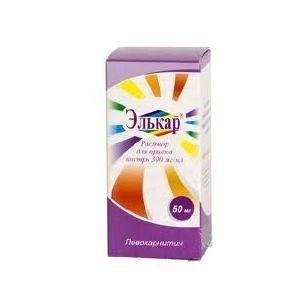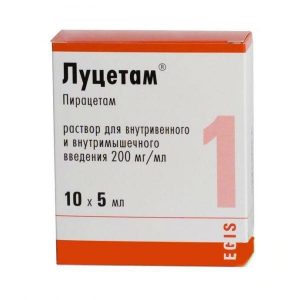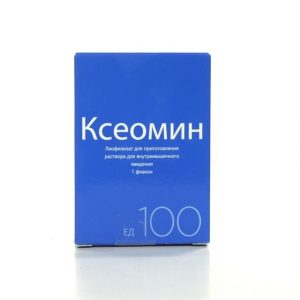Description
Pharmacological action
Pharmacodynamics
Escitalopram is an antidepressant, a selective serotonin reuptake inhibitor with high affinity for the primary binding site. Escitalopram also binds to the allosteric binding site of the transporter protein, with a thousand-fold lower affinity. Allosteric modulation of the transporter protein enhances the binding of escitalopram at the primary binding site, which leads to a more complete inhibition of serotonin reuptake.
Escitalopram does not have or has very poor ability to bind to a number of receptors, including: serotonin 5-HT1A, 5-HT2 receptors, dopamine D1 and D2 receptors, 1-, 2-, -adrenoreceptors, H1-histamine, m -cholinergic receptors, benzodiazepine and opioid receptors.
Pharmacokinetics
Absorption
Absorption is almost complete and does not depend on the meal time. The average time to reach maximum plasma concentration (TCmax) is 4 hours after repeated use. The absolute bioavailability of escitalopram is about 80%.
Distribution
The apparent volume of distribution (Vd / F) after oral administration is 12 to 26 l / kg. The binding of escitalopram and its main metabolites to plasma proteins is below 80%. The kinetics of escitalopram is linear. The equilibrium concentration (Css) is reached after about 1 week, the average Css – 50 nmol / L (from 20 to 125 nmol / L) is achieved with a daily dose of 10 mg.
Metabolism
Escitalopram is metabolized in the liver to demethylated and didemethylated metabolites. Both are pharmacologically active. Nitrogen can be oxidized to an N-oxide metabolite. The main substance and its metabolites are partially excreted in the form of glucuronides. After repeated use, the average concentrations of demethylated and didemethylated metabolites are 28-31% and less than 5%, respectively, of the concentration of escitalopram.
The biotransformation of escitalopram into a demethylated metabolite occurs mainly with the help of the isoenzyme CYP2C19, some participation of the isoenzymes CYP3A4 and CYP2D6 is possible.
Excretion
The elimination half-life (T1 / 2) after repeated use is about 30 hours.
Clearance for oral administration (Cloral) is 0.6 l / min. In the main metabolites, escitalopram T1 / 2 is longer. Escitalopram and its main metabolites are excreted by the liver (metabolic pathway) and the kidneys, most are excreted in the form of metabolites in the urine.
Special patient groups
Elderly patients (over 65)
In elderly patients (over 65), escitalopram is excreted more slowly than in younger patients. The amount of escitalopram in the systemic circulation the area under the concentration-time curve (AUC) calculated using a pharmacokinetic indicator is 50% more in elderly patients than in healthy young volunteers.
Polymorphism (streets with low activity of CYP2CI9 or CYP2D6 isoenzymes) In patients with low activity of CYP2C19 isoenzyme, the concentration of escitalopram in blood plasma can be 2 times higher than in patients with high activity of this isoenzyme. Significant changes in the concentration of escitalopram in blood plasma with low activity of the CYP2D6 isoenzyme were not detected.
Indications
Depressive episodes of any severity.
Panic disorder with / without agoraphobia.
Obsessive-compulsive disorder.
Composition
Active ingredient: Escitalopram oxalate 12.78 mg (equivalent to escitalopram 10.00 mg) Excipients, 117 mg total, 23 mg 87 mg, microcrystalline cellulose 57.50 mg, croscarmellose sodium 6.60 mg, acesulfame potassium 2.20 mg, neohesperidin-dihydrochalcon 0.20 mg, peppermint flavor * 1.10 mg, magnesium stearate 2, 20 mg
Dosage and administration of
Elicea taken orally, regardless of food intake.
Depressive episodes: 10-20 mg once a day. After the disappearance of the symptoms of depression, it is necessary to continue therapy to consolidate the effect for 6 months.
Panic disorders (including agoraphobia): 5 mg / day during the first week, then 10-20 mg / day. The maximum daily dose is 20 mg. The duration of treatment is several months. Upon termination of treatment, the dose should be gradually reduced within 1-2 weeks in order to avoid the occurrence of withdrawal syndrome.
In elderly patients (over 65), the recommended dose is 5 mg / day, the maximum daily dose is 10 mg. In mild to moderate renal failure, dose adjustment is not required. The recommended initial dose for decreased liver function during the first two weeks of treatment is 5 mg / day. Depending on the individual response of the patient, the dose may be increased to 10 mg / day.
For patients with weak CYP2C19 isoenzyme activity, the recommended initial dose for the first two weeks of treatment is 5 mg / day. Depending on the individual response of the patient, the dose may be increased to 10 mg / day.
Side effects
Side effects often occur in the first or second week of treatment and subsequently become less intense, and their frequency decreases with further treatment.
Very often ( 1/10):
– headache
– nausea
Often ( 1/100, <1/10): decreased appetite, increased appetite, weight gain fear, anxiety, abnormal dreams, women and men: decreased libido, women: anorgasmia insomnia, drowsiness, dizziness, paresthesia, tremor sinusitis, yawning diarrhea, constipation, vomiting, dry mouth increased sweating arthralgia, myalgia men: ejaculation disorders, impotence fatigue, fever Not often ( 1/1000, 1/100): weight loss bruxism, aging, nerves, aging confusion impaired taste, sleep disturbance, syncope mydriasis, visual impairment tinnitus tachycardia nosebleeds gastrointestinal bleeding (including rectal bleeding) urticaria, alopecia, rash, woman rash, rash Niya, menorrhagia swelling rare (1/10000, 1/1000 ): anaphylactic reactions aggression, depersonalization, hallucinations serotonin syndrome bradycardia It is very rare ( 1/10000) it is not known (cannot be determined from the available data) whether it is associated with taking the drug: thrombocytopenia impaired secretion of the antidiuretic hormone cerebrospinal hypertension, anorexia, dyskinesia, motor disorders, convulsions, psychomotor tension / akathisia prolongation of the ECT QT interval, ventricular arrhythmia, including torsade de pointes ventricular tachycardia orthostatic hypothesis hepatitis, abnormal liver function test results angioedema, ecchymosis urinary retention galactorrhea men: priapism withdrawal symptoms, observed with discontinuation of treatment Discontinuation of SSRIs / SSRIs, especially abrupt, often leads to the development of withdrawal syndrome. The most commonly reported reactions include dizziness, impaired sensory functions (paresthesia and sensation of electric shock), sleep disorders (in particular insomnia and restless dreams), agitation or fear, vomiting and / or nausea, tremor, confusion, increased sweating, headache pain, diarrhea, palpitation, emotional instability, irritability and visual disturbances. In most cases, these symptoms are mild or moderate, but in some patients they can be serious and / or prolonged. Therefore, in the case when treatment with escitalopram is no longer required, the abolition of escitalopram should be carried out gradually, by gradually reducing the dose. Drug Interactions When taken with MAO inhibitors, the risk of developing serotonin syndrome and serious adverse reactions increases. Joint use with serotonergic drugs (including tramadol, sumatriptan, and other triptans) can lead to the development of serotonin syndrome. Concomitant use with drugs that lower the threshold of convulsive readiness increases the risk of seizures. Enhances the effect of tryptophan and Li + drugs. Increases the toxicity of St. John’s wort. Enhances the effect of drugs that affect blood coagulation (monitoring of blood coagulation parameters is necessary). Drugs metabolized with the participation of the CYP2C19 system (including omeprazole), as well as being strong inhibitors of CYPЗА4 and CYP2D6 (including flecainide, propafenone, metoprolol, desipramine, clomipramine, nortriptyline, risperidone, thioridazine, haloperidol), increase the concentration of escitalopram. Increases the plasma concentration of desipramine and metoprolol 2 times. Overdose Symptoms: dizziness, tremor, agitation, drowsiness, serotonin syndrome, convulsions, depression of consciousness of varying severity (especially in combination with alcohol and / or other drugs that depress the central nervous system), nausea, vomiting, decreased blood pressure, tachycardia ECG changes (ST segment change, T wave, QRS complex expansion, QT interval increase), arrhythmias, respiratory depression, metabolic acidosis, rhabdomyolysis, hypokalemia, hyponatremia. Treatment: conduct symptomatic and supportive therapy: gastric lavage, intake of activated carbon, ensuring airway patency, adequate oxygenation, monitoring the functions of the cardiovascular and respiratory systems. There is no specific antidote. Dosage form tablets




